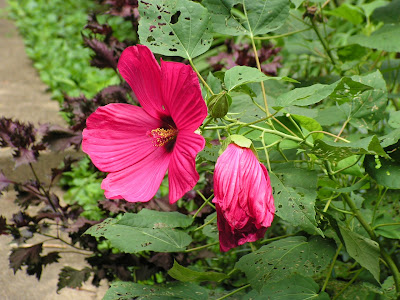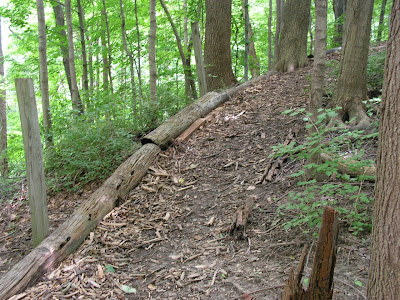
When my ripening tomatoes spill over from their spot on the kitchen window sill to also fill the dining room window sill, and the garden basket is full, too...then I know I have enough tomatoes to make tomato garden vegetable juice. And because the canner was hot--and I had almost as many peppers as I had tomatoes, I also made pepper onion relish.
There are a couple of ways to achieve tomato juice. The canning book I have advised you cut off the blossom end, remove the core, put the tomatoes and other veggies for the veggie blend (carrots, celery, green pepper, onion and parsley) into a sauce pot and simmer or 20 minutes before pressing the mix through a food mill to get the juice.
If you do a lot of juicing, however, a juicer is a handy investment.


You can see here, I have my juicer on the kitchen counter. The fruits or vegetables go in the tube at the top, pulp goes into the bucket on the left and juice into the pitcher on the right. It's quick and easy, although rather messy, but then, working with tomatoes always is. After I finished with the tomatoes, I added fresh parsley from the garden, carrots, celery and cauliflower--all leftovers from earlier canning recipes or from my salad fixings.


No matter which way you get your juice, the next step involves heating and seasoning it. Here is where you can do some personalizing. I wanted mine to have a little kick to it, so I used some Cajun seasoning mix, along with a few more fresh herbs from the garden. You'll notice I have a thermometer clipped onto the pot. The goal is to heat the juice to 190 degrees, but not to boil it. I like the clip-on thermometer because I can periodically check it while doing other things. For instance, while the tomato juice heated, I prepped the jars with lemon juice.
 If you're working with an old canning book, you're not as likely to see lemon juice in the ingredients list. That's because tomatoes, historically, were more acidic. Modern varieties have had some of the acidity bred out of them, making them easier on the stomach, but less likely to preserve well in the water bath canner, at least not without a little help. A couple of tablespoons of lemon juice per jar makes up for the lack of acidity.
If you're working with an old canning book, you're not as likely to see lemon juice in the ingredients list. That's because tomatoes, historically, were more acidic. Modern varieties have had some of the acidity bred out of them, making them easier on the stomach, but less likely to preserve well in the water bath canner, at least not without a little help. A couple of tablespoons of lemon juice per jar makes up for the lack of acidity.

I also had time to get my peppers (10 green and 2 sweet red) and onions (1 1/2 medium-size) chopped for the relish, as well as a couple of hot red peppers. I covered them with boiling water first for 5 minutes, and then again with more boiling water for 10 minutes while I finished with the tomato juice. After the tomato juice was in the jars with a fresh sprig of thyme and their caps and rings were applied (see canning salsa post for how this step is done), I put the quart jars in the canner and set them to process for 45 minutes. Remember, to check the water level. Jars need 1 to 2 inches of water at a rolling boil above them for the full 45 minutes.
Then, I began working on the vinegar for the relish. The vinegar mix included 4 teaspoons of mixed pickling spice in a spice bag, 3 1/2 cups of vinegar, 4 teaspoons of salt and 1 1/2 cups of sugar, although if you need to avoid sugar, you can substitute 2 T of a liquid non-sugar sweetener. The vinegar simmered 15 minutes before I added the drained pepper mixture. Then it simmered for another 10. Next, I removed the spice bag before putting the relish into the hot pint jars.

By the way, you might notice the soup pot on the back burner. It's simmering a bisque thickened not with the authentic ground crustacean shells, but with the pulp of some of the extra veggies and herbs that I put through the juicer. (Not the tomatoes, though.) I also floated a little bacon in it as it simmered, just for flavor. The bisque along with an Italian herb bread (simply a white bread with Italian herb seasoning cooked at the rapid bread setting on the bread machine) will be tonight's entree. Not much waste for the compost pile from today's canning endeavors. About the same time the relish is ready for the canner, the tomato juice is finished processing.

While the relish is running through its 15 minutes in the canner,
I'm going to show you a picture of the tomato juice. I want to be sure you are not surprised by what you see if you try this recipe yourself. Home-canned tomato juice separates like you see here. Commercially processed juice uses flash processing with equipment costing thousands of dollars. If you want home-canned tomato juice, you'll probably have to live with the separation. On the positive side, if you float a sprig of thyme or dill in the juice, the jar still looks attractive; what's more, I've heard some upscale restaurants serve the "tomato water" as a pricey beverage option. You can have that tomato water simply by waiting to shake the jar until you've skimmed a little off the top when you open the jar to use.
Finally, the jars of relish and juice are cooling on the cutting board. After a while, I'll check the seals, making sure the lids don't flex up and down at their centers and that I can't pull the lids off with my fingers. If they're sealed, I'll add them to the pantry shelf. If not, I'll add them to the refrigerator for use soon or else re-can them. And speaking of the pantry shelf, a jar of mixed vegetable pickles from last summer should make a nice side dish for tonight's blue "bowl" special.
So the canner's benediction for today would be: may your own kitchen waft with that acrid smell of tomatoes and vinegar soon. And if a drop-by neighbor should sniff the air and ask how long your grandma is staying for this visit, then you'll know you've found your place in the summer canners' hall of fame.



















































